Info
The habitat of Cheilinus fasciatus could apply to this species. Cheilinus quinquecinctus inhabits relatively shallow coral reefs and sandy areas near reefs, to about 30 m depth.
As with other species of the genus representatives of this species live mainly solitary and do not congregate in large numbers.
The wrasse perch feeds mainly on hard-shelled prey, including crustaceans, sea urchins and various mollusks.
Jumping guard
A jumping guard prevents (nocturnal) fish from jumping out.
Wrasses, blennies, hawkfishs and gobies jump out of an unprotected tank in fright if their night rest is disturbed, unfortunately these jumpers are found dried up in the morning on carpets, glass edges or later behind the tank.
https://www.korallenriff.de/en/article/1925_5_Jump_Protection_Solutions_for_Fish_in_the_Aquarium__5_Net_Covers.html
A small night light also helps, as it provides the fish with a means of orientation in the dark!
As with other species of the genus representatives of this species live mainly solitary and do not congregate in large numbers.
The wrasse perch feeds mainly on hard-shelled prey, including crustaceans, sea urchins and various mollusks.
Jumping guard
A jumping guard prevents (nocturnal) fish from jumping out.
Wrasses, blennies, hawkfishs and gobies jump out of an unprotected tank in fright if their night rest is disturbed, unfortunately these jumpers are found dried up in the morning on carpets, glass edges or later behind the tank.
https://www.korallenriff.de/en/article/1925_5_Jump_Protection_Solutions_for_Fish_in_the_Aquarium__5_Net_Covers.html
A small night light also helps, as it provides the fish with a means of orientation in the dark!







 François Libert, Frankreich
François Libert, Frankreich















